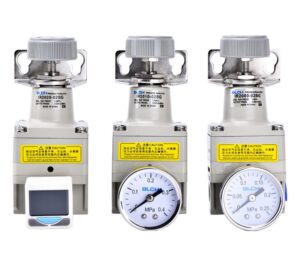1.3 Characteristics of pneumatic technology

Both hydraulics and pneumatics use fluid as the working medium, and convert the energy of fluid into the mechanical movement of actuating elements. Their control elements participate in the same way as the equipment automation. And because there are many similarities in component names, structures, specifications, etc., it is easy to cause the illusion of using the same method to handle. In fact, it is inappropriate to apply hydraulic technology to pneumatic technology intact. Due to different media, the structure of components and the composition method of the system are different.
To correctly select the transmission type, you must understand the characteristics of various transmission technologies and control technologies. See Table 1-1 and Table 1-2.
Table 1-1 Characteristics of Different Transmission Technologies
| project | hydraulic technology | Electrical technology | Pneumatic technology | |
| Energy transmission | transmit | Limited and slow | Fast and long distance transportation | Limited and slow |
| Comparative economic transmission distance | The maximum is about 100m | There are no restrictions | The maximum is about 1000m | |
| Transmission speed | 2~6m/s | About 300000 km / S | 10~15m/s | |
| storage | Possible but limited | difficulty | simple | |
| Energy costs | high | low | Very high | |
| transmission | The generation of linear motion | be prone to | Cumbersome and expensive | be prone to |
| Working speed | It can reach about 0.5m/s | It can reach about 4m / s, and even higher in special cases | ||
| power density | Very high | low | low | |
| Output force | great | It’s quite expensive | Limited, up to 20000 n | |
| Maximum stroke | It can be more than 1m long | Restricted | Up to 2M | |
| Change of output force | Simple and accurate | expensive | simple | |
| Change in speed | Simple and accurate | expensive | simple | |
| efficiency | high | low | low | |
| Generation of rotational motion | simple | simple | simple | |
| speed | Restricted | Restricted | High, up to 50000r / min | |
| Output torque | great | large | Small | |
| Change of speed | Simple and accurate | expensive | It’s simple | |
| Change of torque | Simple and accurate | expensive | simple | |
| efficiency | high | high | low | |
| Laying of roads | Trivial | simple | Very simple | |
| overload protection | Fully equipped | Generally not | Fully equipped | |
| Explosion proof of body | Incomplete | No | have | |
Table 1-2 Characteristics of various control technologies Hydraulic technology
| control technology | Hydraulic technology (3 ~ 8barp) | 50 ~ 500mbar pneumatic technology | Electrical technology | electronic technique | |
| Signal transmission | In general, the transmission distance is more economical than the transmission speed | Slow and limited, about 100m 20 ~ 70m / s | Slow and limited, about 300m, up to 300m / s | It’s fast and no problem. It’s infinitely restricted to 30000km / s | |
| Control element | Action time, dimension and life | 0.1ms small very high | 1ms is very small, very high | 10ms high | 1ms is very small, very high |
| Feeling of the environment | Dust moisture external electromagnetic field heat | It’s not sensitive. It’s not sensitive. It’s not sensitive | It’s sensitive. It’s not sensitive. It’s not sensitive. It’s not sensitive | Very sensitive, very sensitive, insensitive and insensitive | Sensitive very sensitive very sensitive |
| Loop laying | It’s simple | It’s simple | simple | simple | |
| Scale of control system | Restricted | Restricted | Restricted | Limited in practical use | |
| Use and maintenance | be prone to | easily | easily | For professionals, it is easy to use and maintain | |
| ①1bar=105Pa. | |||||





